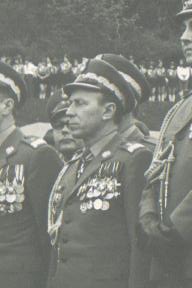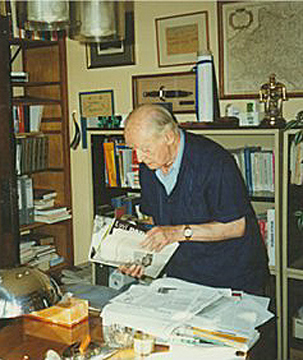|
Władysław Kozaczuk
Władysław Kozaczuk (23 December 1923 – 26 September 2003) was a Polish Army colonel and a military and intelligence historian. Life Born in the village of Babiki near Sokółka, Kozaczuk joined the army in 1944, during World War II, at Białystok. In 1945 he became a Polish Army second lieutenant, and spent the first 5 years of his service commanding operational units of the Internal Security Corps, fighting the Polish anticommunist underground and then the Ukrainian Insurgent Army. In 1950 he was transferred to the Internal Security Corps Staff in Warsaw. In 1954–55, following the Korean War, Kozaczuk carried out armistice-related duties in Korea. In 1955–58 he served in the Polish Ministry of Internal Affairs ('). In 1957–58 he saw duty with the International Control Commission in Vietnam. In 1958–69 he served in Polish military counter-intelligence (''Wojskowa Służba Wewnętrzna''). According to his family, he found conditions there uncongenial ... [...More Info...] [...Related Items...] OR: [Wikipedia] [Google] [Baidu] |
Polish Army
The Land Forces () are the land forces of the Polish Armed Forces. They currently contain some 62,000 active personnel and form many components of the European Union and NATO deployments around the world. Poland's recorded military history stretches back a millennium – since the 10th century (see List of Polish wars and History of the Polish Army). Poland's modern army was formed after Poland regained independence following World War I in 1918. History 1918–1938 When Poland regained independence in 1918, it recreated its military which participated in the Polish–Soviet War of 1919–1921, and in the two smaller conflicts ( Polish–Ukrainian War (1918–1919) and the Polish–Lithuanian War (1920)). Initially, right after the First World War, Poland had five military districts (1918–1921): * Poznań Military District (Poznański Okręg Wojskowy), HQ in Poznań * Kraków Military District (Krakowski Okręg Wojskowy), HQ in Kraków * Łódź Military District (Łódz ... [...More Info...] [...Related Items...] OR: [Wikipedia] [Google] [Baidu] |
Wojskowa Służba Wewnętrzna
The Internal Military Service, ( pl, Wojskowa Służba Wewnętrzna, ''WSW'') Szefostwo, was an armed military counterintelligence, military police, and military secret police within the structure of Ministry of National Defense or (MON). It served and protected the Polish Armed Forces against western and central MON institutions during the years of 1957-1990 in the Polish People's Republic or PRL. History of Polish counterintelligence after World War II Background When Polish communists with the consent of Joseph Stalin start to create a Polish military units in Soviet Union. First unit was formed on 14 May 1943, it was Polish 1st Tadeusz Kosciuszko Infantry Division. A day later, on May 15, 1943 at the division headquarters by the Soviets so-called the Military Information (IW), which was responsible for the political security and counterintelligence in the division. First it was 20 people they were Russians, whom came from soviet formation like SMERSH, NKGB and NKVD ... [...More Info...] [...Related Items...] OR: [Wikipedia] [Google] [Baidu] |
Gustave Bertrand
Gustave Bertrand (1896–1976) was a French military intelligence officer who made a vital contribution to the decryption, by Poland's Cipher Bureau, of German Enigma ciphers, beginning in December 1932. This achievement would in turn lead to Britain's celebrated World War II Ultra operation. Life Bertrand joined the French military as a private in 1914 and was wounded in 1915 at the Dardanelles. From 1926, he worked in radio intelligence. In the 1920s, French radio intelligence was decentralized. Decryption of foreign, chiefly German and Italian, ciphers and codes was the responsibility of a General Staff cryptology department, while radio monitoring was conducted by the intelligence service, ''Service de Renseignement'' or ''S.R.'' At the end of 1930, decryption was turned over to the ''S.R.'', which created a Section ''D'' (for ''Decryptement''), of which Bertrand became chief. He later took over all of French radio intelligence. Bertrand's intelligence associates had ... [...More Info...] [...Related Items...] OR: [Wikipedia] [Google] [Baidu] |
France
France (), officially the French Republic ( ), is a country primarily located in Western Europe. It also comprises of Overseas France, overseas regions and territories in the Americas and the Atlantic Ocean, Atlantic, Pacific Ocean, Pacific and Indian Oceans. Its Metropolitan France, metropolitan area extends from the Rhine to the Atlantic Ocean and from the Mediterranean Sea to the English Channel and the North Sea; overseas territories include French Guiana in South America, Saint Pierre and Miquelon in the North Atlantic, the French West Indies, and many islands in Oceania and the Indian Ocean. Due to its several coastal territories, France has the largest exclusive economic zone in the world. France borders Belgium, Luxembourg, Germany, Switzerland, Monaco, Italy, Andorra, and Spain in continental Europe, as well as the Kingdom of the Netherlands, Netherlands, Suriname, and Brazil in the Americas via its overseas territories in French Guiana and Saint Martin (island), ... [...More Info...] [...Related Items...] OR: [Wikipedia] [Google] [Baidu] |
Cryptologist
This is a list of cryptographers. Cryptography is the practice and study of techniques for secure communication in the presence of third parties called adversaries. Pre twentieth century * Al-Khalil ibn Ahmad al-Farahidi: wrote a (now lost) book on cryptography titled the "''Book of Cryptographic Messages''". * Al-Kindi, 9th century Arabic polymath and originator of frequency analysis. * Athanasius Kircher, attempts to decipher crypted messages * Augustus the Younger, Duke of Brunswick-Lüneburg, wrote a standard book on cryptography * Ibn Wahshiyya: published several cipher alphabets that were used to encrypt magic formulas. * John Dee, wrote an occult book, which in fact was a cover for crypted text * Ibn 'Adlan: 13th-century cryptographer who made important contributions on the sample size of the frequency analysis. * Duke of Mantua Francesco I Gonzaga is the one who used the earliest example of homophonic Substitution cipher in early 1400s. * Ibn al-Durayhim: gave detailed d ... [...More Info...] [...Related Items...] OR: [Wikipedia] [Google] [Baidu] |
Cipher
In cryptography, a cipher (or cypher) is an algorithm for performing encryption or decryption—a series of well-defined steps that can be followed as a procedure. An alternative, less common term is ''encipherment''. To encipher or encode is to convert information into cipher or code. In common parlance, "cipher" is synonymous with "code", as they are both a set of steps that encrypt a message; however, the concepts are distinct in cryptography, especially classical cryptography. Codes generally substitute different length strings of characters in the output, while ciphers generally substitute the same number of characters as are input. There are exceptions and some cipher systems may use slightly more, or fewer, characters when output versus the number that were input. Codes operated by substituting according to a large codebook which linked a random string of characters or numbers to a word or phrase. For example, "UQJHSE" could be the code for "Proceed to the following ... [...More Info...] [...Related Items...] OR: [Wikipedia] [Google] [Baidu] |
Kultura
''Kultura'' (, ''Culture'')—sometimes referred to as ''Kultura Paryska'' ("Paris-based Culture")—was a leading Polish-émigré literary-political magazine, published from 1947 to 2000 by ''Instytut Literacki'' (the Literary Institute), initially in Rome and then in Paris. It was edited and produced by Jerzy Giedroyc and ceased publication upon his death. Giedroyc was one of the main reasons why ''Kultura'' enjoyed an unwavering prestige and a constant stream of esteemed contributors that enabled it to play a prominent role in Polish literary life. ''Kultura'' published polemics and articles, including those by Nobel Prize for Literature laureates Czesław Miłosz and Wisława Szymborska, as well as works by numerous other authors. Literary critics such as Maria Janion, Wojciech Karpiński, Jan Kott, and Ryszard Nycz also contributed. ''Kultura'' was and continues to be essential reading for students of Polish literature. Over the years it printed, and popularised the n ... [...More Info...] [...Related Items...] OR: [Wikipedia] [Google] [Baidu] |
Polish Language
Polish (Polish: ''język polski'', , ''polszczyzna'' or simply ''polski'', ) is a West Slavic language of the Lechitic group written in the Latin script. It is spoken primarily in Poland and serves as the native language of the Poles. In addition to being the official language of Poland, it is also used by the Polish diaspora. There are over 50 million Polish speakers around the world. It ranks as the sixth most-spoken among languages of the European Union. Polish is subdivided into regional dialects and maintains strict T–V distinction pronouns, honorifics, and various forms of formalities when addressing individuals. The traditional 32-letter Polish alphabet has nine additions (''ą'', ''ć'', ''ę'', ''ł'', ''ń'', ''ó'', ''ś'', ''ź'', ''ż'') to the letters of the basic 26-letter Latin alphabet, while removing three (x, q, v). Those three letters are at times included in an extended 35-letter alphabet, although they are not used in native words. The traditional ... [...More Info...] [...Related Items...] OR: [Wikipedia] [Google] [Baidu] |
Paris
Paris () is the capital and most populous city of France, with an estimated population of 2,165,423 residents in 2019 in an area of more than 105 km² (41 sq mi), making it the 30th most densely populated city in the world in 2020. Since the 17th century, Paris has been one of the world's major centres of finance, diplomacy, commerce, fashion, gastronomy, and science. For its leading role in the arts and sciences, as well as its very early system of street lighting, in the 19th century it became known as "the City of Light". Like London, prior to the Second World War, it was also sometimes called the capital of the world. The City of Paris is the centre of the Île-de-France region, or Paris Region, with an estimated population of 12,262,544 in 2019, or about 19% of the population of France, making the region France's primate city. The Paris Region had a GDP of €739 billion ($743 billion) in 2019, which is the highest in Europe. According to the Economist Intelli ... [...More Info...] [...Related Items...] OR: [Wikipedia] [Google] [Baidu] |
Cold War
The Cold War is a term commonly used to refer to a period of geopolitical tension between the United States and the Soviet Union and their respective allies, the Western Bloc and the Eastern Bloc. The term '' cold war'' is used because there was no large-scale fighting directly between the two superpowers, but they each supported major regional conflicts known as proxy wars. The conflict was based around the ideological and geopolitical struggle for global influence by these two superpowers, following their temporary alliance and victory against Nazi Germany and Imperial Japan in 1945. Aside from the nuclear arsenal development and conventional military deployment, the struggle for dominance was expressed via indirect means such as psychological warfare, propaganda campaigns, espionage, far-reaching embargoes, rivalry at sports events, and technological competitions such as the Space Race. The Western Bloc was led by the United States as well as a number of other First W ... [...More Info...] [...Related Items...] OR: [Wikipedia] [Google] [Baidu] |
Doctorate
A doctorate (from Latin ''docere'', "to teach"), doctor's degree (from Latin ''doctor'', "teacher"), or doctoral degree is an academic degree awarded by universities and some other educational institutions, derived from the ancient formalism ''licentia docendi'' ("licence to teach"). In most countries, a research degree qualifies the holder to teach at university level in the degree's field or work in a specific profession. There are a number of doctoral degrees; the most common is the Doctor of Philosophy (PhD), awarded in many different fields, ranging from the humanities to scientific disciplines. In the United States and some other countries, there are also some types of technical or professional degrees that include "doctor" in their name and are classified as a doctorate in some of those countries. Professional doctorates historically came about to meet the needs of practitioners in a variety of disciplines. Many universities also award honorary doctorates to individuals d ... [...More Info...] [...Related Items...] OR: [Wikipedia] [Google] [Baidu] |





.png)
